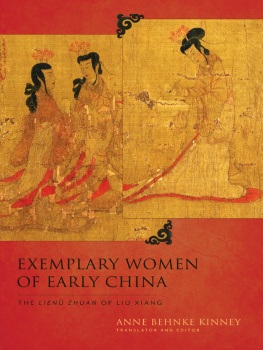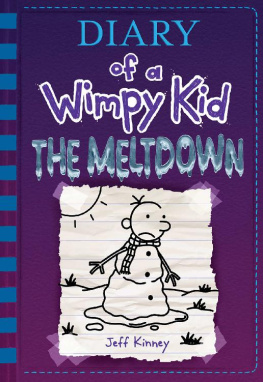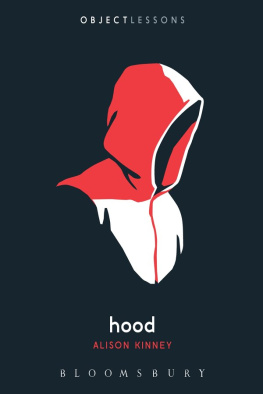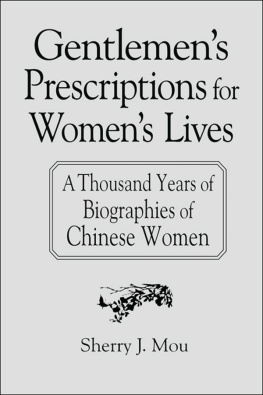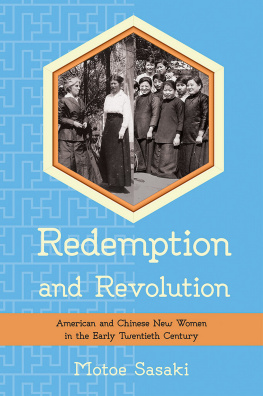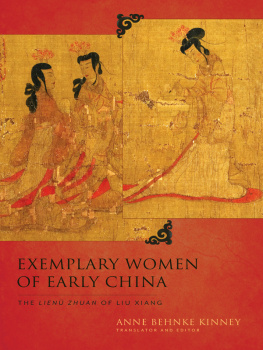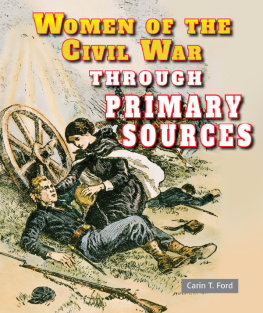EXEMPLARY WOMEN OF EARLY CHINA
TRANSLATIONS FROM THE ASIAN CLASSICS
TRANSLATIONS FROM THE ASIAN CLASSICS
Editorial Board
Wm. Theodore de Bary, Chair
Paul Anderer
Donald Keene
George A. Saliba
Haruo Shirane
Burton Watson
Wei Shang
ANNE BEHNKE KINNEY
TRANSLATOR AND EDITOR
EXEMPLARY WOMEN OF EARLY CHINA
THE LIEN ZHUAN OF LIU XIANG
COLUMBIA UNIVERSITY PRESS NEW YORK
Columbia University Press
Publishers Since 1893
New York Chichester, West Sussex
cup.columbia.edu
Copyright 2014 Columbia University Press
All rights reserved
E-ISBN 978-0-231-53608-0
Library of Congress Cataloging-in-Publication Data
Liu, Xiang, 77?6? B.C.
[Lie n zhuan]
Exemplary women of early China : the Lien zhuan of Liu Xiang / edited and translated by Anne Behnke Kinney.
pages cm. (Translations from the Asian classics)
Includes bibliographical references and index.
ISBN 978-0-231-16308-8 (cloth : alk. paper) ISBN 978-0-231-16309-5 (pbk.) ISBN 978-0-231-53608-0 (electronic)
1. WomenChinaBiography. 2. WomenChinaConduct of life. I. Kinney, Anne Behnke. II. Title.
CT3710.L5813 2014
920.051dc23
2013002987
A Columbia University Press E-book.
CUP would be pleased to hear about your reading experience with this e-book at .
Cover image: The Trustees of the British Museum. Nushi zhen, Admonitions of the Instructions of the Ladies of the Palace scroll. Zou Yigui & Gu Kaizhi, China. c. 344405.
Cover design: Lisa Hamm
References to websites (URLs) were accurate at the time of writing. Neither the authors nor Columbia University Press is responsible for URLs that may have expired or changed since the manuscript was prepared.
FOR MY BROTHERS, BRUCE AND JOHN, AND MY DAUGHTER, ZOE OLIVIA
CONTENTS








I gratefully acknowledge the help of many colleagues in the writing of this book. The Columbia University Early China seminars; the meetings of the Warring States Working Group arranged by E. Bruce and Takeo Brooks at the University of Massachusetts; the workshop on the Huainanzi organized by Sarah Queen, Michael Puett, and John Major; Clara Wing-chung Hos conference on the sources for Chinese womens history; and the workshops organized by Moss Roberts at New York University all provided valuable opportunities for enhancing my understanding of numerous issues that bear on the Lien zhuan. Among the scholars who participated in these meetings and others who offered their thoughts on various textual and historical issues connected with this book, I am especially grateful to Barry Blakeley, Yuri Pines, Keith Knapp, Grant Hardy, John Major, Sarah Queen, Michael Puett, Sarah Allan, Constance Cook, Moss Roberts, Andy Meyer, Paul Goldin, Bill Baxter, Margaret Pearson, Li Feng, Wang Hongjie, Melvin Thatcher, Dieter Kuhn, Miranda Brown, Susan Mann, Masatsugu Yamazaki, Michiko Niikuni Wilson, Gustav Heldt, and Wolfgang Behr. My editor at Columbia University Press, Leslie Kriesel, deserves special thanks for her keen eye and careful work. I also thank Anne Holmes, who created the index for this volume.
I am also grateful for the generous support of the American Council of Learned Societies, the National Endowment for the Humanities, the Luce Foundation, the University of Virginia, and the University of Virginias East Asia Center, which provided the time and the resources essential to the completion of this project. I am thankful for the assistance of the National Library of China, especially Zhang Zhiqing, director of the Rare Books and Special Collections Department; the Institute for Advanced Technology in the Humanities at the University of Virginia; and the British Museum for their support in the creation of a digital research collection for the study of the Lien zhuan.
My friend and mentor, Eric P. Henry, deserves special thanks. I first met Eric in 1977 in a course on classical Chinese at the Inter-University Center for Chinese Language Studies in Taipei, Taiwan. When I returned to the United States in 1979, I was surprised one day to find that Eric had sent me a copy of Albert OHaras translation of the Lien zhuan. I was at turns fascinated, inspired, and appalled by the stories in this collection. It was just my sort of book! And I suspect that is why Eric sent it to me. When I completed my own translation some thirty years later, Eric kindly read through the entire manuscript and offered innumerable insights and suggestions that are reflected on nearly every page. Any errors that remain are my own.
I would also like to thank my daughter, Zoe Olivia, for creating for me a cardboard Lien zhuan thermometer with 125 degree-marks for each of the 125 biographies. Each time I completed one biography, I was directed to color a line on the thermometer red until the mercury reached the final goal of 125 degrees. I would like to thank my husband, James Daniel Kinney, who provided constant encouragement and thoughtful feedback at each stage of the project and who now knows all 125 women by name. I would finally like to acknowledge three women from the Qing dynasty, Liang Duan (d. 1825), Wang Zhaoyuan (17631851), and Xiao Daoguan (18551907), who, through their commentaries on the Lien zhuan, have been my constant companions during this project and whose wise counsel has guided my translation at every turn.
C ompiled toward the end of the Former Han dynasty (206 BCE to 8 CE), Liu Xiang's (798 BCE)

